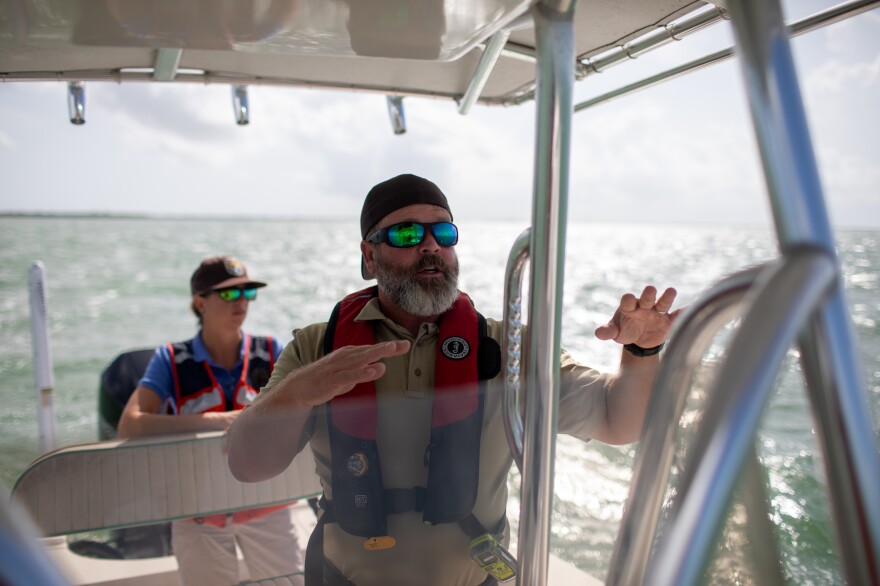Millenia ago, when much of North America was covered in ice, a distant relative of a white-tailed deer grazed its way down a limestone ridge to the southeast edge of the continental U.S. Over time, as the ice melted and seas rose, the limestone ridge was reduced to a series of shrinking islands — or keys — off the South Florida coast. The deer, trapped and isolated from its mainland relatives, shrank too.
Today, the Key deer — or toy deer, as it's sometimes called because of its dog-size stature — is the smallest deer species in North America. It is genetically unique and ridiculously cute. It is Bambi, incarnate.
It is also, possibly, doomed.
Rising seas created the Key deer. Rapidly rising seas, a symptom of human-caused climate change, are challenging its continued existence and raising tough questions for the people trying to keep the nation's more than 1,300 other threatened and endangered species alive.
How do we save an endangered animal like the Key deer when "we know, no matter what, we're going to lose its habitat in the future?" asked Nikki Colangelo, endangered species manager for the U.S. Fish and Wildlife Service's South Florida region.

The Endangered Species Act, which turns 50 this year, tasks wildlife managers like Colangelo with stopping extinction, protecting imperiled species and recovering them to the point where they no longer need federal protection.
"Saving life on Earth," said Martha Williams, director of the U.S. Fish and Wildlife Service. "That's what we're doing."
But in an era of rapid climate change, when entire ecosystems are being eroded by supercharged temperatures, wildfires, hurricanes and drought, what does "saving" a species even mean? What counts?

"The Endangered Species Act is being tested by climate change, and sea-level rise in particular, in these low-lying island ecosystems," said Chris Bergh, Florida field program director for The Nature Conservancy.
Ninety-percent of the Florida Keys' land mass sits 5 feet above sea level or below. The islands are home to 31 federally protected plants and animals, and some 80,000 people.
Bergh, a Keys native and resident who has spent most of his life trying to protect the islands' threatened species, has watched as habitats have shrunk. Pine trees and freshwater-dependent plants and animals have moved "upward and inland," he said. But "sobering" sea-level rise projections — feet of expected water — are forcing an almost existential crisis.

Assuming sea-level rise can't be stopped — and it can't in the immediate term, Bergh said — for the Key deer and other species that live only in unique, disappearing habitats, these are the options: Do nothing, and let a species go extinct. Pick up plants and animals and move them to new areas like higher ground where they risk becoming "invasive species," Bergh said. Collect DNA. Store seeds. Biobank. Take plants to botanical gardens and animals to zoos.
"If you move the Key deer to a series of zoos like people have done with pandas and other endangered species, you can do that and keep them going, but at what cost and to what end?" Bergh asked. "Is that really a future for the species?"

"We're watching islands disappear"
There are an estimated 8 million plant and animal species on the planet. At least a million of them are at risk of extinction — many within decades — because of human actions.
Climate change is already directly threatening more than 10,000 species, but plants and animals that live in only one unique location — endemic species such as the Key deer — are "consistently more adversely impacted," a recent study found.
That's particularly true for island-based species. Geographic isolation, which makes islands cradles of evolution and home to roughly 20% of the Earth's biodiversity, has a downside. Isolation also makes island species disproportionately vulnerable to shifts in their environment such as habitat loss, overexploitation, invasive species and climate change.
"We know even in the best case scenario for sea-level rise, we're going to lose habitat for all of these species," said Colangelo, standing on the back of a boat off the north mangrove-lined shore of Big Pine Key.

The highest natural point on Big Pine Key, the main habitat for the Key deer, is 8 feet above sea level. From the water, the islands around it look like coasters on a roiling aqua countertop.
"Climate change is happening to all of us, it's just really easy to see on these tiny, low-lying islands," said Christian Eggleston, with the Florida Keys National Wildlife Refuge Complex. "Roads are underwater, different things are eroding away, and we're watching islands disappear."
Sea levels globally have risen 6 to 8 inches over the last century. In South Florida, officials are preparing for another 17 inches of sea-level rise by 2040. An analysis by the The Nature Conservancy and Florida International University found that 5 feet of sea-level rise around the Keys would put $27 billion in property and 56,000 people at risk of inundation.
Knowing how much habitat will be lost, Colangelo said it's unlikely wildlife managers will be able to recover species in the places where they currently are.
"That's why we need to be considering some of these other strategies," she said. "Those are difficult conversations as an agency. Politically, socially, what kind of support are we going to get for, let's just say, translocating [picking up and moving] deer to different places?"

A 2011 study by researchers at Florida International University and the Fairchild Tropical Botanic Garden in South Florida looked at the conservation options for two animal and plant species in the Florida Keys in the face of a "perhaps no-analog future."
Conserving species in a changing world, its authors wrote, "will require a new dialogue that includes controversial ideas, a review of existing laws and policies, and preparation for the oncoming change."
"That paper was written in 2011 and there's nothing further that's been done," said Mike Ross, an ecologist at Florida International University who co-authored the study. "It's just at an impasse. Meanwhile, sea levels are coming up at, now, almost a centimeter a year."

The Key deer has been saved before
The tragedy of the Key deer is that if not for climate change, the species is a conservation success story.
As recently as the 1950s, after decades of poaching and habitat loss, there were only about two dozen Key deer left on the planet. "We nearly lost them," said Nova Silvy, a retired biologist with Texas A&M University who was one of the first to study Key deer.
A collection of conservationists, including the Boone and Crockett Club, realizing the urgency of the situation, stepped in. They bought land for the deer to live on and they paid for a game warden to protect them.
That game warden, Jack Watson, a close friend of Silvy's, became a local legend, known for waiting out poachers in swamps and shooting holes in the carburetors of their cars. In 1957, the National Key Deer Refuge became one of the first wildlife refuges in the country.
In 1973, a U.S. President's Advisory Committee panel warned that the greenhouse effect was a matter of "real concern." Congress overwhelmingly passed the Endangered Species Act, a landmark law aimed at protecting critically threatened species from extinction.
"Nothing is more priceless and more worthy of preservation than the rich array of animal life with which our country has been blessed," said Republican President Richard Nixon at the signing.
The Key deer was one of the first species to be listed as endangered in the U.S. — alongside others like the California condor, bald eagle, grizzly bear and American alligator.
The protections worked. Ninety-nine percent of the species that have gotten federal protections from the Endangered Species Act still exist today. The Key deer's population soared. Today, there are an estimated 1,000 Key deer — so many that on Big Pine Key residents give them names and put up fencing around their gardens to keep their plants safe.
"It's not that the deer are endangered anymore," said Silvy. "The habitat is endangered."

Deer, like humans, prefer high ground. The deer's preferred habitat — open expanses of pine dotted forest called pine rockland — only exists where saltwater can't reach. Between development and sea-level rise, pine rockland has been reduced to only about 2% of its historic range on South Florida's urbanized tip.
Deer, also like people, require fresh water. As sea levels rise and hurricanes get more intense, natural freshwater resources are shrinking or becoming brackish. Some residents on Big Pine Key now put out buckets or troughs of water for their neighborhood herds.
"People love them," said Roel Lopez, director of the Natural Resources Institute at Texas A&M. "It's a species that people can kind of connect to."
That, he said, is part of what makes some of the choices ahead, like moving deer to new habitats, so hard.
"Some have argued, and I could argue either point: Is a Key deer still a Key deer outside of its natural habitat?" said Lopez, who has spent 30 years studying the deer. "That's a great question. I don't know."

"We are doing the best we can for as long as we can"
If love for Key deer was measured in wall space, Valerie Preziosi would be the clear winner. A retired nurse, Preziosi is founder and president of the nonprofit conservation group Save Our Key Deer and is also a photographer. Her home, on a narrow strip of land south of Big Pine Key, is filled with photos of resident deer. Fuzzy-antlered bucks. Dot-speckled does.
"The key deer is like an umbrella species that covers all of the lesser-known endangered species underneath them," she said as a herd grazed on her grass outside.
Preziosi has heard all of the options for the Key deer: Let them go extinct, move them to the Bahamas or mainland Florida, where they could successfully breed with normal white-tailed deer, or put them in zoos.
She's familiar with federal, state and nonprofit efforts to preserve and restore habitat. An ongoing project by the U.S. Fish and Wildlife Service and the Florida Fish and Wildlife Conservation Commission aims to restore Big Pine Key's largest freshwater wetland.
"We are doing the best we can for as long as we can," Colangelo said.
For Preziosi, the question of what to do in the long term comes down to ethics.
"This is not a natural event, this is human-caused," she said, of rapidly increasing sea-level rise. "So we owe it to these deer to preserve them the best that we can. So if we need to translocate them to higher ground, we should do that."
The U.S. Fish and Wildlife Service has no active plans to move deer to new environments, but the agency's director, Martha Williams, said she'd like to "not take any tools off the table."
"We have always looked at the Endangered Species Act as creatively and flexibly as we can," she said, noting efforts the Biden administration has undertaken to expand potential habitats for threatened and endangered species.
In July, the Department of Interior published a new rule allowing, for the first time, "experimental populations" of species to be introduced to places they haven't "historically lived."
Climate change is significantly changing habitats for wildlife all over the world. Ocean temperatures are soaring, scorching coral reefs. Precipitation patterns are shifting. Hotter air temperatures are causing plants and animals to move to higher, cooler elevations and new latitudes, north and south.
Off the shore of a slowly disappearing Big Pine Key, on the Gulf of Mexico's bathtub warm waters, Colangelo said she thinks it's well-past time wildlife managers and conservationists start "considering other strategies that maybe we haven't considered before."
"We can't stand back and do nothing," she said. "Our mission is to conserve and protect fish, wildlife and plants. But where is society on that?"
Copyright 2023 NPR. To see more, visit https://www.npr.org.





